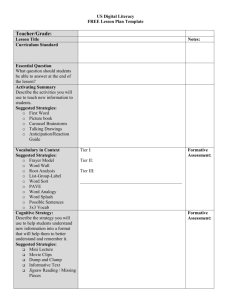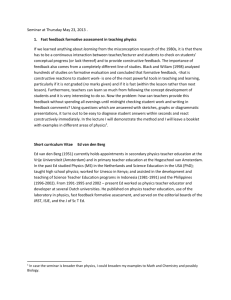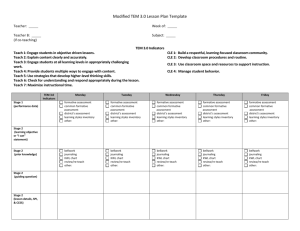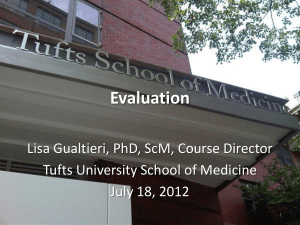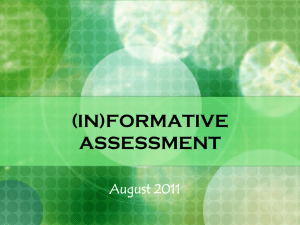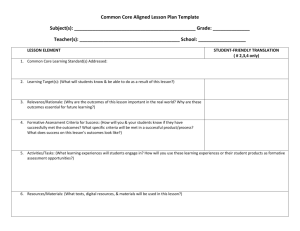Lesson Plan Template
advertisement
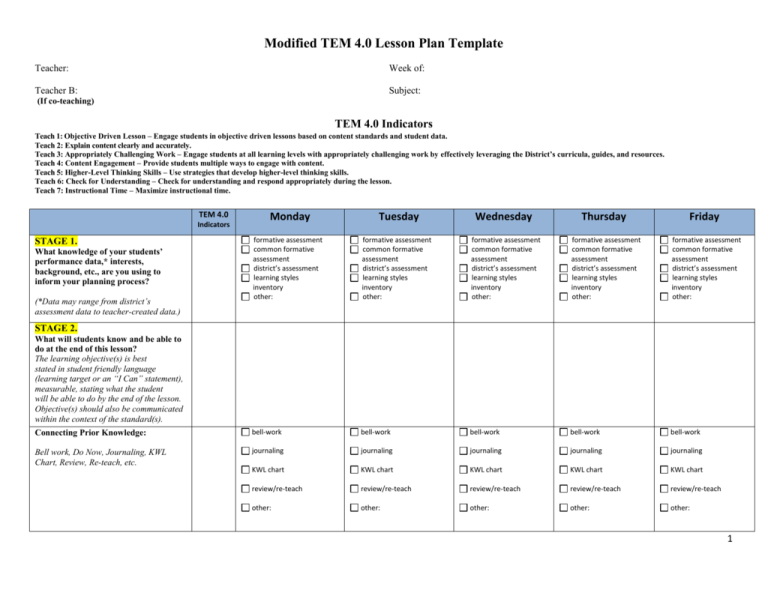
Modified TEM 4.0 Lesson Plan Template Teacher: Week of: Teacher B: Subject: (If co-teaching) TEM 4.0 Indicators Teach 1: Objective Driven Lesson – Engage students in objective driven lessons based on content standards and student data. Teach 2: Explain content clearly and accurately. Teach 3: Appropriately Challenging Work – Engage students at all learning levels with appropriately challenging work by effectively leveraging the District’s curricula, guides, and resources. Teach 4: Content Engagement – Provide students multiple ways to engage with content. Teach 5: Higher-Level Thinking Skills – Use strategies that develop higher-level thinking skills. Teach 6: Check for Understanding – Check for understanding and respond appropriately during the lesson. Teach 7: Instructional Time – Maximize instructional time. TEM 4.0 Monday Tuesday Wednesday Thursday Friday formative assessment common formative assessment district’s assessment learning styles inventory other: formative assessment common formative assessment district’s assessment learning styles inventory other: formative assessment common formative assessment district’s assessment learning styles inventory other: formative assessment common formative assessment district’s assessment learning styles inventory other: formative assessment common formative assessment district’s assessment learning styles inventory other: Connecting Prior Knowledge: bell-work bell-work bell-work bell-work bell-work Bell work, Do Now, Journaling, KWL Chart, Review, Re-teach, etc. journaling journaling journaling journaling journaling KWL chart KWL chart KWL chart KWL chart KWL chart review/re-teach review/re-teach review/re-teach review/re-teach review/re-teach other: other: other: other: other: Indicators STAGE 1. What knowledge of your students’ performance data,* interests, background, etc., are you using to inform your planning process? (*Data may range from district’s assessment data to teacher-created data.) STAGE 2. What will students know and be able to do at the end of this lesson? The learning objective(s) is best stated in student friendly language (learning target or an “I Can” statement), measurable, stating what the student will be able to do by the end of the lesson. Objective(s) should also be communicated within the context of the standard(s). 1 Guiding Question(s): What are the questions that will drive the content and skills that you will teach? Higher order, open-ended, and frequently asked questions begin with “how” or “why”. Can be the driving question for the lesson or for a longer period of time (i.e., week, unit). STAGE 3. What instructional task(s) will be used to reach the learning target? Think about the standard’s level of rigor (revised Bloom’s taxonomy) when developing the task(s). Task(s): Think about including one or more of these instructional strategies: Literacy, interventions, differentiation, anticipation of students’ misconceptions, students guiding their learning, accommodations/modifications, extension of knowledge, scaffolding where appropriate, small groups, whole group, etc. How will you maximize the instructional time with each task? Introduction (approximate time): Guided Practice (approximate time): In what ways will your learners attempt to explain or do what you have outlined? How will you monitor and coach their performances? (WE DO) literacy intervention(s) differentiation anticipation of students’ misconceptions modeling students guiding their learning accommodations/ modifications extension of knowledge scaffolding small groups/ peer- teaching whole group lecture other: preview new learning/ skills review previous learning/skills literacy intervention(s) differentiation anticipation of students’ misconceptions modeling students guiding their learning accommodations/ modifications extension of knowledge scaffolding small groups/ peer- teaching whole group lecture other: preview new learning/ skills review previous learning/skills literacy intervention(s) differentiation anticipation of students’ misconceptions modeling students guiding their learning accommodations/ modifications extension of knowledge scaffolding small groups/ peer- teaching whole group lecture other: preview new learning/ skills review previous learning/skills literacy intervention(s) differentiation anticipation of students’ misconceptions modeling students guiding their learning accommodations/ modifications extension of knowledge scaffolding small groups/ peer- teaching whole group lecture other: preview new learning/ skills review previous learning/skills literacy intervention(s) differentiation anticipation of students’ misconceptions modeling students guiding their learning accommodations/ modifications extension of knowledge scaffolding small groups/ peer- teaching whole group lecture other: preview new learning/ skills review previous learning/skills discussion Q&A graphic organizers exercises/problems prompting/cues note-taking Think-Pair-Share educational games reading aloud stages of the writing process other: discussion Q&A graphic organizers exercises/problems prompting/cues note-taking Think-Pair-Share educational games reading aloud stages of the writing process other: discussion Q&A graphic organizers exercises/problems prompting/cues note-taking Think-Pair-Share educational games reading aloud stages of the writing process other: discussion Q&A graphic organizers exercises/problems prompting/cues note-taking Think-Pair-Share educational games reading aloud stages of the writing process other: discussion Q&A graphic organizers exercises/problems prompting/cues note-taking Think-Pair-Share educational games reading aloud stages of the writing process other: 2 exercises/problems worksheet homework note-taking graphic organizers reading/annotating stages of the writing process other: pre-assessment formative (individual teacher) formative (common) summative post-assessment discussions performance/ demonstration product other: exercises/problems worksheet homework note-taking graphic organizers reading/annotating stages of the writing process other: pre-assessment formative (individual teacher) formative (common) summative post-assessment discussions performance/ demonstration product other: exercises/problems worksheet homework note-taking graphic organizers reading/annotating stages of the writing process other: pre-assessment formative (individual teacher) formative (common) summative post-assessment discussions performance/ demonstration product other: exercises/problems worksheet homework note-taking graphic organizers reading/annotating stages of the writing process other: pre-assessment formative (individual teacher) formative (common) summative post-assessment discussions performance/ demonstration product other: exercises/problems worksheet homework note-taking graphic organizers reading/annotating stages of the writing process other: pre-assessment formative (individual teacher) formative (common) summative post-assessment discussions performance/ demonstration product other: Closure (approximate time) How will you engage students (not the teacher) in restating or demonstrating their learning? Closure strategies are usually the last 5 minutes of class: 3-2-1, ticket out the door, journals, reflective stems, answering guiding question, PMI, etc. 3-2-1 ticket out the door journal reflective stem answering guiding question do one more other: 3-2-1 ticket out the door journal reflective stem answering guiding question do one more other: 3-2-1 ticket out the door journal reflective stem answering guiding question do one more other: 3-2-1 ticket out the door journal reflective stem answering guiding question do one more other: 3-2-1 ticket out the door journal reflective stem answering guiding question do one more other: Resources and Materials Needed for Addressing the Task Consider any differentiated materials needed based on the developed tasks and student modifications (all levels). textbook ancillary materials workbook handout manipulatives PowerPoint presentation video/movie/music technology other: textbook ancillary materials workbook handout manipulatives PowerPoint presentation video/movie/music technology other: textbook ancillary materials workbook handout manipulatives PowerPoint presentation video/movie/music technology other: textbook ancillary materials workbook handout manipulatives PowerPoint presentation video/movie/music technology other: textbook ancillary materials workbook handout manipulatives PowerPoint presentation video/movie/music technology other: Independent Practice (approximate time): How will your different learners attempt the objective on their own? How will you gauge mastery? (THEY DO) Assessment (approximate time) How will you know that students have reached the targeted learning? Assessments may include: Pre-assessment, formative assessment, summative assessment, post-assessment, discussions, performance, demonstration, etc. STAGE 4. Thinking About This Lesson How well did the students achieve the learning targets based on your evidence? What surprises, questions, dilemmas, or problems did you encounter? Thinking Ahead What will you do next for your students; why? Consider students who mastered the learning target at different levels or not at all 3 4
